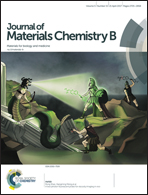Stimuli-responsive biodegradable and gadolinium-based poly[N-(2-hydroxypropyl) methacrylamide] copolymers: their potential as targeting and safe magnetic resonance imaging probes†
Abstract
Gadolinium [Gd(III)]-based polymeric vehicles are gaining attention as potential magnetic resonance imaging (MRI) probes for cancer imaging and diagnosis. In this study, we designed, prepared, and characterized biodegradable block poly[N-(2-hydroxypropyl) methacrylamide] (polyHPMA) copolymer–Gd(III) conjugates through reversible addition–fragmentation chain transfer (RAFT) polymerization, and examined their potential as efficient and biocompatible MRI probes with features that include tunable tumor targeting specificity. An enzyme-sensitive glycylphenylalanylleucylglycine linker (GFLG) was introduced to the backbone of the copolymers, resulting in the formation of a stimuli-responsive linear HPMA copolymer-based agent (pHPMA–DOTA–Gd). The peptide cRGDyK was linked to the copolymer pHPMA–DOTA–Gd, and the resulting copolymer (pHPMA–DOTA–Gd–cRGD) was investigated as a potentially active tumor-targeting MRI contrast agent. The copolymer–Gd(III) conjugates with high molecular weight (MW > 90 kDa) degraded to segments with low MWs (<44 kDa) below the renal threshold. Compared with the clinical agent diethylenediaminepentaacetic acid (DTPA)–Gd, the polymeric conjugates exhibited three-fold more T1 relaxivity [15.16 mM−1 s−1 per gadolinium]. Additionally, gadolinium-based conjugates had greater tumor accumulation in the U87 tumors in mice, and therefore, offered enhanced signal intensity (SI) to MRI. The best in vivo imaging behaviors were mediated by cRGD functionalized conjugates. The 2 polymeric conjugates presented no significant side effects as measured by cytotoxicity, hemocompatibility, and in vivo toxicity studies. Therefore, owing to their great efficacy and good biosafety, the biodegradable block HPMA copolymer–Gd(III) conjugates are promising as targeting MRI probes.
![Graphical abstract: Stimuli-responsive biodegradable and gadolinium-based poly[N-(2-hydroxypropyl) methacrylamide] copolymers: their potential as targeting and safe magnetic resonance imaging probes](/en/Image/Get?imageInfo.ImageType=GA&imageInfo.ImageIdentifier.ManuscriptID=C6TB03253B&imageInfo.ImageIdentifier.Year=2017)


 Please wait while we load your content...
Please wait while we load your content...